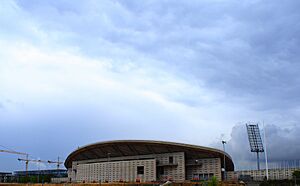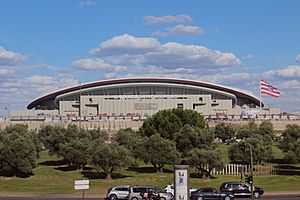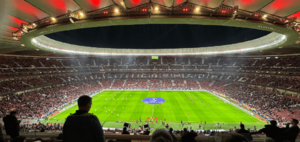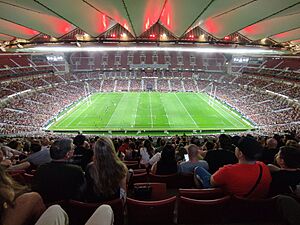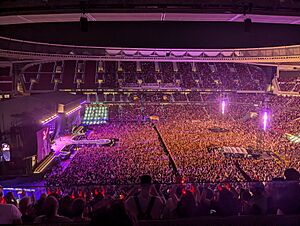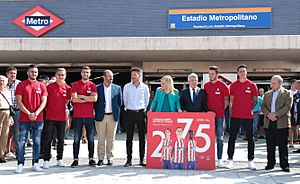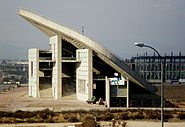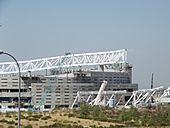Metropolitano Stadium facts for kids

|
|
| Full name | Riyadh Air Metropolitano |
|---|---|
| Former names | Wanda Metropolitano (2017–2022) Cívitas Metropolitano (2022–2024) |
| Location | Madrid, Spain |
| Public transit | |
| Owner | Community of Madrid (1992–2002) City of Madrid (2002–2017) Atlético Madrid (2017–present) |
| Operator | Atlético Madrid |
| Capacity | 70,692 (football) 60,000 (concerts) |
| Record attendance | 70,112 vs Real Madrid (29 September 2024) |
| Field size | 105 m × 68 m (115 yd × 74 yd) |
| Surface | Grass |
| Construction | |
| Built | 1990–93 |
| Opened | 6 September 1994 |
| Renovated | 2017 |
| Closed | 2004 |
| Reopened | 16 September 2017 |
| Construction cost | €45 million (1994) €240 million (2017) |
| Architect | Cruz y Ortiz Arquitectos |
| Main contractors | FCC |
| Tenants | |
| Atlético Madrid (2017–present) Rayo Majadahonda (2018) Spain national football team (selected matches) |
|
The Metropolitano Stadium (called Estadio Metropolitano in Spanish) is a famous football stadium in Madrid, Spain. It's also known as the Riyadh Air Metropolitano Stadium because of a sponsorship deal. This amazing stadium is located in the Rosas neighborhood of Madrid. It has been the home ground for the Atlético Madrid football team since the 2017–18 season.
The stadium was first built for Madrid's attempt to host the 1997 World Athletics Championships. It opened on September 6, 1994. It closed in 2004 when Madrid tried to host the 2016 Olympics, but didn't win the bid. In 2013, Atlético Madrid took over the stadium. It was completely rebuilt and reopened on September 16, 2017. The first match in the new stadium was between Atlético Madrid and Málaga in La Liga.
When it first closed, the stadium could hold 20,000 people. After being rebuilt, it could seat 68,456 fans. By September 2023, its capacity grew to 70,460. Now, with new skyboxes and VIP seats, it can hold 70,692 spectators. The stadium hosted the exciting 2019 UEFA Champions League final on June 1, 2019. It might even be one of the places where the 2030 FIFA World Cup games are played!
Contents
What's in a Name?
This stadium has had a few different names over the years. It was once called Estadio de la Comunidad de Madrid (Community of Madrid Stadium). People also knew it as Estadio Olímpico de Madrid (Madrid Olympic Stadium). Its most common nickname was Estadio de La Peineta, which means "The Comb Stadium." This was because of its unique shape.
In 2016, a Chinese company called Wanda Group bought the rights to name the stadium. So, it became the Wanda Metropolitano. After that deal ended in 2022, a real estate company named Cívitas Pacensis became the new naming partner. The stadium was then called Cívitas Metropolitano. On October 9, 2024, Riyadh Air, an airline, became the latest naming partner. Now, it's known as the Riyadh Air Metropolitano Stadium. However, for big European football events, UEFA rules mean it's simply called Estadio Metropolitano.
Stadium History
In the early 1990s, Madrid wanted to host the World Athletics Championships. To prepare, they started building a stadium in eastern Madrid. It was near the M-40 motorway and the Madrid–Barajas Airport.
Construction began in 1990, following a design by Cruz y Ortiz. The stadium was finished in November 1993 and cost about €45 million. It officially opened in September 1994. Important people like IOC president Juan Antonio Samaranch attended the opening. This first stadium had 20,000 seats and was known as La Peineta because one of its stands looked like a traditional hair comb.
Athens ended up hosting the 1997 World Championships in Athletics. So, La Peineta was used for smaller sports and cultural events for about ten years.
A New Stadium for Atlético
In 2004, the stadium closed because Madrid was trying to host the 2012 Summer Olympics. That bid didn't work out. In 2008, Atlético Madrid's president, Enrique Cerezo, and Madrid's mayor agreed that Atlético would move to the stadium. They planned for renovations to begin. The club was supposed to move in 2013, but this was delayed many times. The delays were due to more Olympic bids and money problems.
After Madrid's bid for the 2016 Olympics also failed, people wondered what would happen to the stadium. In 2011, demolition work started. In 2012, more work removed the lower seats and the running track.
Madrid tried one more time for the 2020 Summer Olympics, but that bid also failed in September 2013. A few days later, Atlético Madrid announced their plans. They would build a new stadium on the site of La Peineta. The club officially took ownership of the land.
The new stadium was planned to replace the Vicente Calderón Stadium. It would be Atlético's home for the 2017–18 season. On December 9, 2016, the club announced the new name: Wanda Metropolitano. The "Wanda" part was for sponsorship. "Metropolitano" honored an older stadium where Atlético played from 1923 to 1966. In March 2017, the club bought the stadium from the City Council of Madrid for €30.4 million. By April 2017, about 48,500 fans had already reserved season tickets!
On September 16, 2017, the Estadio Metropolitano opened with a 2017–18 La Liga match. Atlético Madrid played against Málaga. King Felipe VI of Spain even attended the game. Atlético's Antoine Griezmann scored the very first goal in the new stadium, and Atlético won 1-0. On September 27, 2017, the Metropolitano hosted its first European game. Chelsea beat Atlético Madrid 2–1. They were the first English club to win there in a European competition. The stadium was also the first in the world to use 100% LED lighting.
Exciting Events
The original La Peineta stadium hosted the second game of the 1996 Supercopa de España on August 28. Atlético beat Barcelona 3–1 that night. However, Barcelona won the overall competition.
In 2002, La Peineta hosted the 9th IAAF World Cup. This was a big international track and field event.
On September 20, 2017, soon after the new stadium opened, UEFA chose it. It would host the final match of the 2018–19 UEFA Champions League. This was the fifth European Cup/UEFA Champions League final held in Madrid. The others were at the Santiago Bernabéu Stadium, home of Atlético's rival, Real Madrid.
On March 27, 2018, the stadium hosted the Spain national football team for the first time. They played a friendly match against Argentina and won 6–1.
On April 21, 2018, the stadium held the 2018 Copa del Rey Final. Sevilla played against Barcelona. Barcelona won the game 5–0. During the match, Andrés Iniesta was substituted. The fans gave him a standing ovation because it was his last final with Barcelona.
On March 17, 2019, the Metropolitano hosted a Spanish women's league match. Atlético Madrid played Barcelona. A record 60,739 spectators watched the game. This set a new worldwide record for a women's club football match!
On June 1, 2019, the stadium hosted the 2019 UEFA Champions League Final. Tottenham Hotspur played Liverpool. Liverpool won the match 2–0.
| UEFA Champions League finals | ||||||
|---|---|---|---|---|---|---|
| Season | Winners | Score | Runners-up | Attendance | ||
| 2018–19 | Liverpool |
2-0 | 63,272 | |||
Other Fun Events
The stadium has also hosted several rugby union matches. The Spanish team played against the Classic All Blacks in 2022. Over 40,000 people watched that game. In 2023, Spain played against Argentina here. In July 2023, the stadium hosted "La Velada del Año," a celebrity boxing event. More than 70,000 tickets were sold, making it the biggest boxing event in Spain since 1930.
In 2024, the stadium hosted the final of the World Rugby Sevens Series.
Concerts
The Metropolitano Stadium is also a popular place for big concerts! Many famous artists have performed here.
| Concerts at Estadio Metropolitano | |||
|---|---|---|---|
| Date | Artist | Tour | Attendance |
| 22 June 2018 | Bruno Mars | 24K Magic World Tour | — |
| 14 July 2018 | Iron Maiden | Legacy of the Beast Tour | — |
| 11 June 2019 | Ed Sheeran | Divide Tour | 51,944 |
| 15 June 2019 | Alejandro Sanz | La Gira | — |
| 29 June 2019 | Manuel Carrasco | La Cruz del Mapa | — |
| 7 July 2019 | Bon Jovi | This House is Not For Sale | 54,040 |
| 26 July 2019 | Muse | Simulation Theory Tour | 50,719 |
| 1 June 2022 | The Rolling Stones | Sixty | 52,752 |
| 4 June 2022 | Alejandro Sanz | Sanz en Vivo | — |
| 24 June 2022 | Vetusta Morla | Cable a Tierra | 35,822 |
| 3 June 2023 | Rockin'1000 | — | |
| 7 June 2023 | Pet Shop Boys | Dreamworld | — |
| 9 June 2023 | Guns N' Roses | World Tour 2023 | — |
| 23 June 2023 | Rammstein | Rammstein Stadium Tour | 49,210 |
| 18 July 2023 | The Weeknd | After Hours til Dawn Tour | 54,568 |
| 12, 14 & 17 June 2024 | Bruce Springsteen | Springsteen & E Street Band 2024 World Tour | 161,379 |
| 21 June 2024 | Morat | Los Estadios | 55,000 |
| 22 June 2024 | Estopa | 25 Aniversario | — |
| 12 & 14 July 2024 | Metallica | M72 World Tour | 123,697 |
| 30 & 31 May 2025 | Ed Sheeran | Mathematics Tour | 140,000 |
| 14 June 2025 | Lola Indigo | La Bruja, la Niña y el Dragón | 65,000 |
| 20 & 21 June 2025 | Dellafuente | Los Estadios | 130,000 |
| 28 June 2025 | Imagine Dragons | Loom World Tour | 55,000 |
| 5 July 2025 | Iron Maiden | Run for Your Lives World Tour | 55,000 |
| 12 & 16 July 2025 | AC/DC | Power Up Tour | — |
| 22 July 2025 | Stray Kids | Dominate World Tour | 55,000 |
| 30 & 31 July 2025 | Aitana | Metamorfosis Season | 110,000 |
| 30 & 31 May, 2, 3, 6, 7, 10, 11, 14 & 15 June 2026 | Bad Bunny | Debí Tirar Más Fotos World Tour | — |
Getting to the Stadium
Getting to the Metropolitano Stadium is quite easy, especially with public transport. The Madrid City Council and other groups worked to improve how people access the stadium.
The main way to get there is by Madrid Metro. You can take Metro Line 7 directly to the Estadio Metropolitano station. This station has a very large platform to handle many fans.
There are also three other Metro stations within a short walk:
- Las Rosas (on Line 2)
- Canillejas (on Line 5)
- Las Musas (on Line 7)
Many EMT Madrid buses stop near the stadium. These include lines 28, 38, 48, 140, 153, E2, N5, and N6. The N5 and N6 are night buses. On match days, the EMT even runs a special bus service (SE721 line) from the Canillejas transport hub directly to the stadium. Canillejas connects to Metro Line 5 and other bus lines.
Construction Gallery
See also
 In Spanish: Estadio Metropolitano (Madrid) para niños
In Spanish: Estadio Metropolitano (Madrid) para niños
- Lists of stadiums
- Football in Spain


